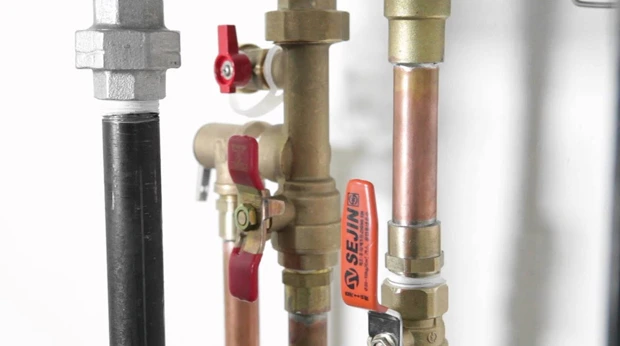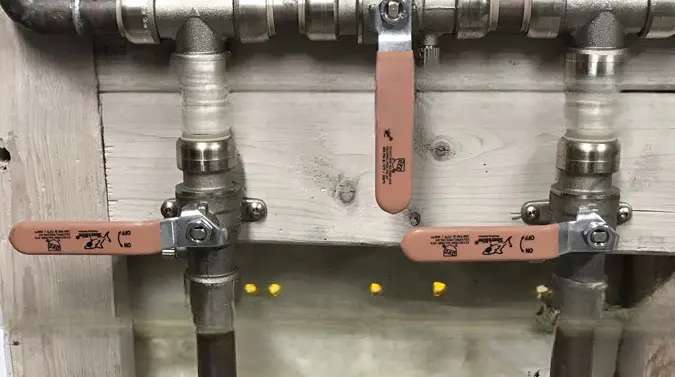Last Updated on May 31, 2023
A water softener removes high concentrations of magnesium and calcium that accumulate in hard water through a filtration system. But one necessary maintenance task is periodically shutting off the water softener valve.
This allows the system to be flushed out of accumulated sediment, eventually leading to clogs and other complications. But how do you carefully turn off the water softener valve to ensure it doesn’t get damaged?
Your water softener can be turned off by closing the input and output valves by about a quarter, followed by opening the bypass valve by a quarter. While it may seem simple, shutting off the water softener valve is essential to keeping the system running smoothly.
To ensure that your water softener works efficiently for a long time, continue reading to find out how to do this safely.
How to Turn Off Water Softener Valves Safely?

Ordinary hard water is unsafe for your plumbing, as it can erode the pipes and lead to mineral buildup that reduces water flow and affects water quality. A water softener removes these minerals from your water, making it safer for your pipes and appliances.
If you need to turn off your water softener valves for any reason, follow these steps:
Step 01. Find the Power Switch and Switch it Off
If you have an electrical water softener, make sure that it is turned off by locating the power switch. The power switch is a simple on/off switch located on the side or back of the water softener unit. If you do not have any power switches, you have a non-electrical water softener.
Step 02. Locate the Water Softener Valves
With the power switch turned off, locate the water softener valves. These are typically located on the side of your water softener unit and may be either manual or digital. Manual valves will require you to turn a knob or lever to adjust the water flowing into your pipes, while digital valves will have buttons to press or dials to turn.
There may be three valves on your water softener: a bypass valve, an inlet valve, and an outlet valve. The bypass valve controls water flow to your home, while the inlet and outlet valves control water flow into and out of the water softener unit.
Step 03. Close Inlet and Outlet Valves by a Quarter Turn
To turn off your water softener, you must close the valves of the water softener by a quarter turn, allowing the water to drain out of the water softener safely. The inlet valve is located where water enters the softener, while the outlet valve is located at the end where water leaves the softener.
To turn off the inlet and outlet valve, rotate them clockwise until they are closed by a quarter turn. Once both valves are turned off, your water softener will be slightly disconnected from the water supply.
Step 04. Open the Bypass Valve With a Quarter Turn
After you have closed off the inlet and outlet valves, turn on the bypass valve by rotating it counterclockwise until it is open by a quarter turn. This will allow water to flow freely around the water softener unit, effectively turning off your water softener.
Different types of bypass valves require different turning options:
#1 For a 3-valve bypass:
It usually has labels indicating “bypass” and “service” or similar, along with an arrow or metal point indicating the current setting. Turn the valve with a quarter turn in the same direction as the inlet and outlet valves. This ensures that all valves are facing the same direction.
#2 For an All-in-One Bypass/Push Bypass:
Look for a push knob labeled “bypass” or “on/off.” There are two main types: push-push and push-pull valves. For push-pull valves, push the knob in from one side and pull it back out from the other.
Step 05. Open a Water Faucet to Release Any Pressure
Before you shut down the water softener outlet valve, open a nearby faucet to discharge any pressure built up inside your softener pipes. This will help prevent damage to your plumbing system from high-pressure water bursts when you disconnect the unit.
Also, if water is still flowing from the water softener, wait for it to stop before turning off the outlet valve. Once the pressure has been released, you can safely close your water softener outlet valve. To fully flow the water through your home, you may need to open the bypass valve.
Why Do You Need to Turn Off the Soften Water Valve?

If you have a water softener, you may have wondered why you sometimes need to shut off the soft water valve. This valve allows regular water to flow into your home rather than softened water.
1. Accessing Regular Water
To access regular water, you must temporarily turn off the water softening function using the water softener bypass valve. This valve allows you to use regular tap water that is not softened.
You may need to do this if you prefer the taste of regular water or if you need un-softened water for certain appliances or tasks, such as watering your garden or filling a swimming pool.
2. Water Softener Bypass Valve Leaking
If you notice a bypass valve leaking or water leaking from the top of your water softener, you should immediately turn off the soft water valve. This will prevent further damage to your system and save your money.
The leaking valve can cause damage to your appliances or the flooring and walls surrounding the water softener. Turning off the soft water valve will stop the water flow and give you time to repair the leak.
3. To Prevent Mineral Buildup
Water softeners use salt to remove minerals from the water, but over time, those minerals can accumulate on the softener’s parts, which reduces its efficiency. To prolong the life of your water softener, you may need to turn off the soft water valve periodically.
This will allow regular water to flow through the system and flush out mineral buildup. Doing this can help maintain the efficiency of the water softener and prolong its useful life.
When Should the Water Softener Valve be Turned Off?

Most people don’t know when the water softener valve should be turned off. The answer is:
- When you are going on vacation
- When performing system maintenance
- When the water softener is faulty
Going on vacation is the most common reason to close the water softener valve. If you are gone for more than a week, turning off the water softener will save you money on your water bill. It will also save you from a high water bill when you get home.
Switching off the water softener valve is always a good idea when performing system maintenance. This will prevent any damage to the system while you are working on it.
Also, if your water softener is faulty, it is best to turn off the valve until you can repair or replace it. This will prevent any further damage to your home’s plumbing.
Consequences of Not Turning Off the Water Softener Valve?
Water softener systems are designed to remove the minerals from your water that can cause all sorts of problems, from clogged pipes to dry skin. But what happens if you forget to turn off the softener valve when you vacation?
The consequences can be pretty significant, such as:
- The resin beads in the water softener system will continue to attract and remove minerals from the water, even though there’s no need to do so. This can lead to a decrease in water pressure and an increase in your water bill.
- The beads can become overloaded and break down, clog your pipes and require costly repairs.
- During a power outage, the water softener will continue to run, consuming salt and water without softening any water.
- If the power is restored and there is still salt in the brine tank, the softened water will contain too much salt. This can cause problems with plumbing fixtures and appliances that use water.
- If the water softener is not turned off before doing laundry, clothes may become stiff, and difficult to remove wrinkles.
To avoid these problems, close the water softener valve when necessary.
Should You Turn Off the Water Softener When the Home Water is Off?
In the case of water softeners, it is always a good idea to shut the water softener off when the home water is turned off. This will prevent the unnecessary use of salt and water, resulting in higher household bills.
Turning off your water softener during periods of no water prevents the resin bed from becoming saturated and prolongs your water softener’s life. Also, turning off your softener will reduce your water bill, as you are not paying to treat water that is not being used.
Will a Water Softener Regenerate When the Valve is Turn Off?

When a water softener is not used, the regeneration process will not occur. This is because the process is triggered by water usage, and since no water is being used, the system does not need to regenerate.
Occasionally, you may see a slight amount of water being used during regeneration, but this is usually due to leaks and is not enough to trigger the process.
The only time a water softener will need to be manually regenerated is if it has been turned off for an extended period and the salt level has become too low. When this happens, you can simply turn on the control valve and allow the system to regenerate itself.
Do Water Softeners Have an On/Off Valve?
If you have a water softener in your home, you might wonder if it has an on/off valve. The answer is yes, and most water softeners will have an on/off valve that can be used to control the water flowing into the unit.
This valve is typically located near the inlet for the incoming water supply. In some cases, the on/off valve may be located on the front of the unit, while others may be on the back. If you’re unsure where to find your water softener’s on/off valve, consult your owner’s manual or contact the manufacturer.
Some commercial softeners often have a three-valve bypass operation for maintenance and repair. This allows the user to shut off the water softener while using water in the home.
Is it Safe to Turn Off the Water Softener Valve?

The answer is yes, as long as you remember to turn it back on when you return. Water softener systems use an ion exchange process to remove minerals like calcium and magnesium from your water. Minerals can accumulate on your pipes and fixtures, causing feelings of soap film and scale buildup.
Turning off the valve stops the water flow through the system, so there is no chance of the resin beads getting dirty or clogged while you’re away. Just be sure to set a reminder to turn the shutoff valve back on when you get home so that you can enjoy soft water again.
Turn Off Your Water Softener Valve to Ensure Your Plumbing Safety
While turning off your water softener valve may seem intimidating initially, it is a straightforward process with just a few steps. Following the aforementioned steps, you can shut off your water softener valve quickly, safely, and efficiently.
Whether clearing out buildup or performing routine maintenance, a proper shutdown is key to avoiding mishaps. Now that you know how to turn off your water softener valve, go ahead and try it out.
But remember, always take the necessary precautions to keep yourself and those around you safe when working on your household appliances.


